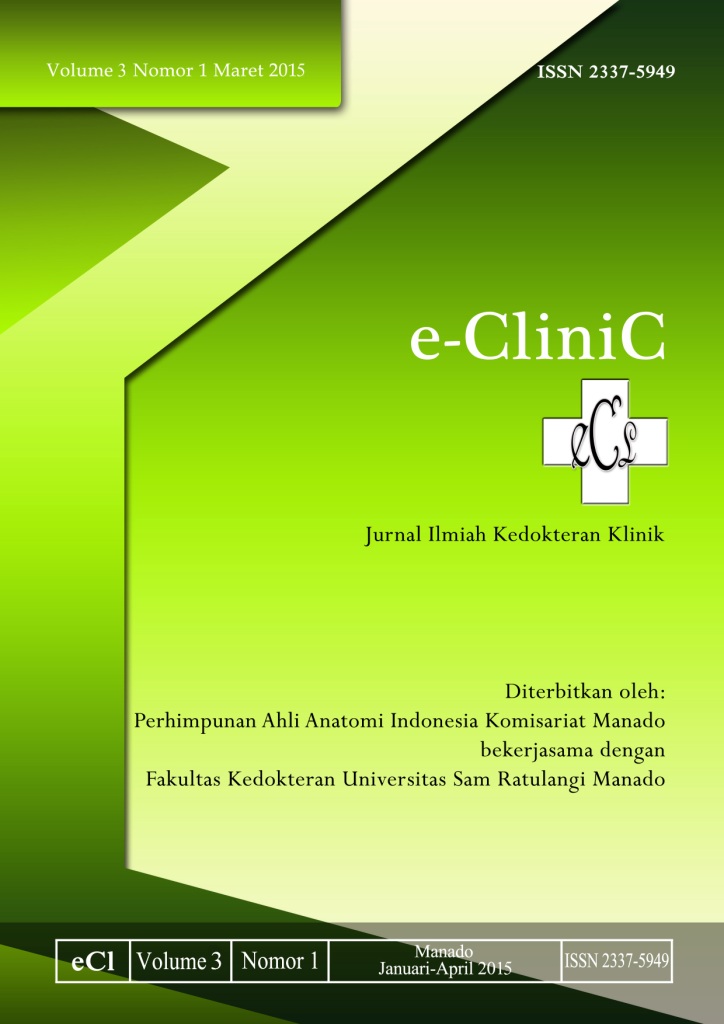PROFIL CONTENT SCALE MINNESOTA MULTIPHASIC PERSONALITY INVENTORY-2 (MMPI-2) ADAPTASI INDONESIA PADA MAHASISWA SEMESTER 1 TAHUN AKADEMIK 2013/2014 FAKULTAS KEDOKTERAN UNIVERSITAS SAM RATULANGI
DOI:
https://doi.org/10.35790/ecl.v3i1.6513Abstract
Abstract: Human being as an early adult often faces problems in his/her daily activities, especially as a new student entering the college environment. These problems arise because of the process of adjustment to the new environment. If the student is not able to overcome the problems it can cause negative effects in their daily life as the prosecution of science, so it can lead to emotional disorders such as anxiety and depression. This was a cross survey study that was designed to assess the mental status of the 1st year freshmen college students class 2013/2014 at Unsrat Medical Faculty by using clinical and subclinical scale MMPI-2 in Indonesian adaptation. A univarian analysis using Microsoft Excel software were used for the data analysis. The results showed that from 101 respondent there were 72.28% females. There were 64.36% came from North Sulawesi, but more students came from other areas outside North Sulawesi (53.47%), who had 2 siblings (33.67%). Their parents were working on a private sector (43.57%). Score’s distribution content scale MMPI-2 from the highest to lowest; SOD (35.64%), WRK (19.80%), ANX (17.82%), TRT (14.85%), ANG (11.88%), OBS (10.89%), LSE (9.90%), FRS (8.91%), DEP (8.91%), CYN (4.95%), BIZ (2.97%), ASP (2.97%), respectively. Dominant outcomes from the content component scale based on the content scale’s scores; SOD1 : 30 students, SOD2 : 19 students, respectively. Conclusion: The most dominant scale from the highest score is the social discomfort scale and work interference scale.
Keywords: college student, profile, content scale, content component scale, MMPI-2.
Abstrak: Manusia dalam kehidupannya sebagai orang dewasa awal, seringkali menghadapi masalah dalam aktifitasnya sehari-hari. Terlebih lagi seorang mahasiswa yang baru memasuki lingkungan perkuliahan. Permasalahan tersebut timbul oleh karena adanya proses penyesuaian diri dengan lingkungan barunya itu. Jika mahasiswa tidak mampu mengatasi permasalahan tersebut maka dapat menimbulkan efek negatif dalam kesehariannya sebagai penuntut ilmu, sehingga dapat berujung kepada gangguan emosional seperti cemas dan depresi.Penelitian ini merupakan penelitian survei potong lintang untuk mengetahui status mental mahasiswa semester 1 tahun akademik 2013/2014 FK UNSRAT dengan menggunakan skala content scale dan content component scale MMPI-2 adaptasi Indonesia. Analisa data berupa analisis univariat dengan menggunakan microsoft excel. Hasil penelitian memperlihatkan bahwa distribusi mahasiswa dari 101 responden yang memiliki hasil valid berdasarkan sosiodemografi terbanyak pada perempuan (72,28%), berasal dari daerah Sulawesi Utara (64,36%) namun lebih banyak berasal dari suku yang berada di luar Sulawesi Utara (53,47%), memiliki jumlah saudara 2 orang (33,67%) dan anak ke 1 dalam keluarga (40,59%) dan pekerjaan orang tua di bidang swasta (43,56%). Distribusi skor tinggi skala klinis MMPI-2 berturut turut dari yang paling tinggi ke rendah yaitu SOD (35.64%), WRK (19.80%), ANX (17.82%), TRT (14.85%), ANG (11.88%), OBS (10.89%), LSE (9.90%), FRS (8.91%), DEP (8.91%), CYN (4.95%), BIZ (2.97%), ASP (2.97%). Hasil yang menonjol pada skala content component scale berdasarkan skor tinggi content scale berturut-turut adalah; SOD1 : 30 orang, SOD2 : 19 orang. Simpulan: Skala yang paling menonjol dari skor tinggi ialah skala social discomfort dan skala work interference
Kata kunci: mahasiswa, profil, content scale, content component scale, MMPI-2.
Downloads
Published
How to Cite
Issue
Section
License
COPYRIGHT
Authors who publish with this journal agree to the following terms:
Authors hold their copyright and grant this journal the privilege of first publication, with the work simultaneously licensed under a Creative Commons Attribution License that permits others to impart the work with an acknowledgment of the work's origin and initial publication by this journal.
Authors can enter into separate or additional contractual arrangements for the non-exclusive distribution of the journal's published version of the work (for example, post it to an institutional repository or publish it in a book), with an acknowledgment of its underlying publication in this journal.
Authors are permitted and encouraged to post their work online (for example, in institutional repositories or on their website) as it can lead to productive exchanges, as well as earlier and greater citation of the published work (See The Effect of Open Access).







